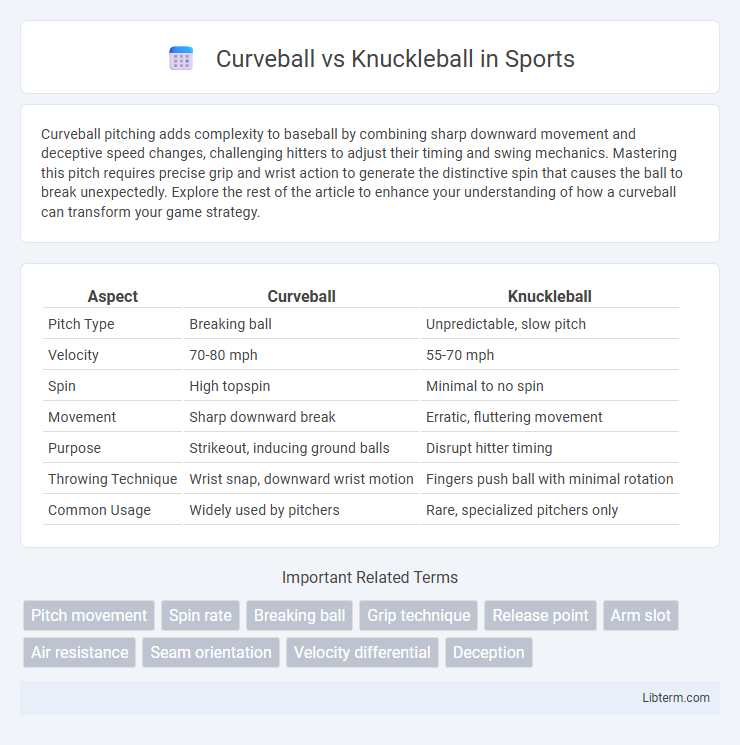Curveball pitching adds complexity to baseball by combining sharp downward movement and deceptive speed changes, challenging hitters to adjust their timing and swing mechanics. Mastering this pitch requires precise grip and wrist action to generate the distinctive spin that causes the ball to break unexpectedly. Explore the rest of the article to enhance your understanding of how a curveball can transform your game strategy.
Table of Comparison
| Aspect | Curveball | Knuckleball |
|---|---|---|
| Pitch Type | Breaking ball | Unpredictable, slow pitch |
| Velocity | 70-80 mph | 55-70 mph |
| Spin | High topspin | Minimal to no spin |
| Movement | Sharp downward break | Erratic, fluttering movement |
| Purpose | Strikeout, inducing ground balls | Disrupt hitter timing |
| Throwing Technique | Wrist snap, downward wrist motion | Fingers push ball with minimal rotation |
| Common Usage | Widely used by pitchers | Rare, specialized pitchers only |
Introduction to Curveball and Knuckleball
The curveball is a breaking pitch in baseball characterized by its sharp downward movement, achieved through forward spin created by the pitcher's grip and wrist motion. The knuckleball, in contrast, is thrown with little to no spin, resulting in unpredictable, floating movement that confuses batters. Both pitches require specialized grips and techniques, making them distinct weapons in a pitcher's arsenal.
Defining the Curveball: Mechanics and Technique
The curveball is a pitch characterized by its sharp, downward spin created through a gripping technique where the pitcher places the middle finger along the seam and snaps the wrist upon release, generating significant topspin. This mechanics cause the ball to break downward abruptly as it approaches the plate, deceiving hitters with its distinct trajectory. Mastery of the curveball requires precise wrist action and finger pressure to control the angle and speed of the break, distinguishing it from the unpredictable fluttering motion of the knuckleball.
Understanding the Knuckleball: Unique Characteristics
The knuckleball features an unpredictable, fluttering flight path caused by minimal spin, making it difficult for batters to anticipate its movement. Unlike the curveball, which relies on significant spin to create sharp, downward breaks, the knuckleball's lack of spin leads to erratic, floating motion. This unique characteristic challenges both hitters and catchers, as the pitch's fluttering trajectory defies conventional baseball physics.
Historical Evolution of Curveballs and Knuckleballs
The historical evolution of curveballs traces back to the late 19th century when pitcher Candy Cummings reportedly threw the first successful curveball, revolutionizing pitching with its distinct downward break caused by the ball's spin. The knuckleball, emerging in the early 20th century, gained prominence through pitchers like Eddie Cicotte and later Phil Niekro, characterized by its unpredictable fluttering motion due to minimal spin, challenging batters with erratic trajectories. Both pitches have evolved through adaptations in grip and release techniques, shaping modern pitching strategies and influencing the art of throwing specialty pitches in baseball history.
Key Differences in Grip and Delivery
The curveball grip involves placing the index and middle fingers along the seam with the thumb underneath, creating a tight wrist snap during release to generate a downward spin. The knuckleball grip uses the fingertips or knuckles to hold the ball loosely without spin, relying on an erratic motion caused by minimal wrist action. Curveballs feature a defined spinning trajectory, whereas knuckleballs rely on unpredictability due to the absence of spin.
Movement Patterns: Curveball vs. Knuckleball
The curveball exhibits a pronounced downward and lateral movement due to its topspin created by the pitcher's grip and wrist action, causing the ball to break sharply as it approaches the plate. In contrast, the knuckleball has an erratic, unpredictable flight path with minimal spin, resulting from the pitcher releasing the ball with fingertips or knuckles, making it flutter or dance in the air. Pitchers use the curveball's consistent break to deceive hitters with a defined trajectory, while the knuckleball relies on its volatile movement to disrupt the batter's timing and judgment.
Strategic Uses in Game Situations
Curveballs, characterized by their sharp downward break, are strategically deployed to disrupt a hitter's timing and induce ground balls or swings and misses, especially effective with two strikes. Knuckleballs, with unpredictable, fluttering movement, confuse batters by reducing bat speed precision, often used to exploit hitters' timing during critical or high-pressure at-bats. Pitchers leverage curveballs to exploit batter weaknesses in specific counts, while knuckleballs are ideal for extending innings and conserving arm strength by limiting hard contact.
Notable Pitchers: Masters of Each Pitch
Notable curveball pitchers include Sandy Koufax, whose devastating curve baffled hitters in the 1960s, and Clayton Kershaw, known for his sharp and consistent curve that complements his fastball. In contrast, knuckleball masters like Phil Niekro and Tim Wakefield relied on the unpredictable flutter of the knuckleball to disrupt timing and induce weak contact. These pitchers have become synonymous with their signature pitches, showcasing the distinct strategic value and skill required to master the curveball and knuckleball in Major League Baseball.
Advantages and Challenges of Each Pitch
Curveballs offer precise downward movement that can deceive batters by breaking sharply, making them effective for generating swings and misses; however, mastering consistent release points and spin control presents significant challenges for pitchers. Knuckleballs provide unpredictable, fluttering trajectories due to minimal spin, disrupting hitters' timing and balance, but their slow velocity and difficulty in command increase the risk of passed balls and walks. Both pitches require specialized techniques and can diversify a pitcher's arsenal by contrasting speed and movement, yet demand rigorous practice to overcome inherent control difficulties.
Choosing the Right Pitch: When to Use Curveball or Knuckleball
Selecting between a curveball and knuckleball depends on the hitter's timing and anticipated reaction. Use a curveball when aiming to deceive with sharp downward movement, especially effective against aggressive batters prone to swinging early. Opt for a knuckleball to disrupt timing with unpredictable fluttering, ideal when facing hitters who excel at adjusting to conventional breaking pitches.
Curveball Infographic

 libterm.com
libterm.com